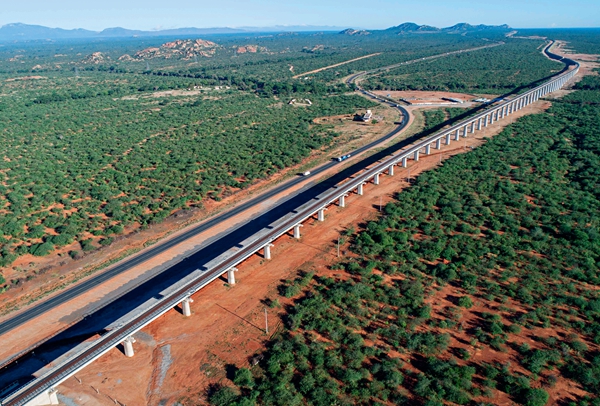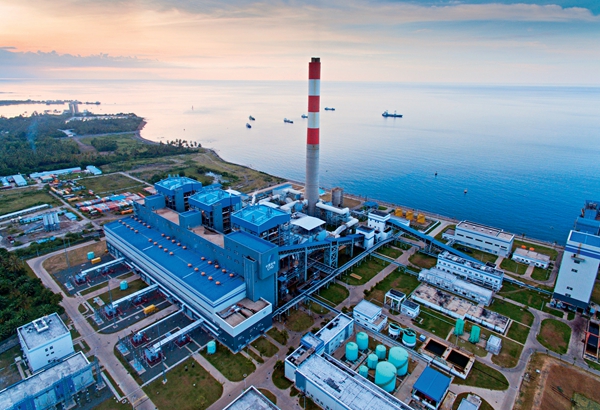By staff reporter LIU YI
By staff reporter LIU YI
LARGE scale infrastructure projects are doubtless the first things that come to mind upon mention of the Belt and Road Initiative. In the recently concluded Belt and Road Forum for International Cooperation, however, it was the concept of sustainable development which was underlined as a key principle in rolling out the initiative.
As Chinese President Xi Jinping said in his keynote speech at the forum, “We must pursue a new vision of green development and way of life and work which is green, low-carbon, circular and sustainable.” A few days prior to the forum, the Chinese government issued official guidelines on promoting a “green” Belt and Road and intermeshing the sustainable concept with the entire implementation process, by incorporating environmental assessment, green product standards, and corporate social responsibility.

Erik Solheim, executive director of the UN Environment and under-secretary-general of the United Nations, commended China’s “green” efforts. “The Belt and Road Initiative should expedite the interconnectivity of green development concepts and infrastructure,” Solheim told China Today on the sidelines of the Belt and Road Forum. He went on to talk about the initiative’s influence on the course of sustainable development.
Economy and Environment Simultaneously Addressed
On a global scale, countries and regions along the Belt and Road generally have a deep concern about environmental vulnerability. This partly explains recurrent criticisms of and oppositions to new investment and projects. The prevailing mindset is that development is at the expense of the environment.
Solheim regards this as an outdated attitude. “Economic prosperity and a good environment can be simultaneously achieved.” The salient example Solheim raised was the Mombasa-Nairobi railway, the latest incarnation of China’s interconnectivity dream on the African continent.
Having started operations on May 31, the railway connecting Kenya’s capital and its largest port cuts the travel time between the two cities from 11 hours to about four hours, so slashing costs by up to 40 percent. Kenyan President Uhuru Kenyatta said on his Twitter that the railway will “reshape the story of Kenya for the next 100 years.”

The project, however, came under close scrutiny even before construction started in 2014. Despite the associated costs, its environmental impact was a major concern. As the railway cuts through several national parks, conservationists worried that it might hinder the free migration of wild animals.
The Chinese constructors hence hit on reserving 14 “passages” on overhead viaducts specifically for animals’ migration, the solution applied a decade ago during the building of the railways on the Qinghai-Tibet Plateau. At a height of up to seven meters, the passages allow the safe transit of animals as tall as giraffes. Fences are also installed along the entire line to keep wild animals off the tracks.
The notion that economic development and natural conservation are incompatible, therefore, is obsolete, said Solheim. The head of UN Environment calls for a new sustainable development concept whose emphasis is on developing economy via sustainable methods and technologies.
“Such massive investment in development is on a scale never before seen,” said Solheim, adding that if the Belt and Road Initiative were to be carried out in a sustainable, climate friendly way, millions could witness the benefits of green growth. “Green hills are golden hills,” he quoted, so signifying his agreement with President Xi’s observation in his keynote speech.
New Mechanism for Realizing a Sustainable 2030
Sustainable development has become the consensus among the international community since the unanimous adoption of the 2030 Agenda for Sustainable Development by the UN members in September 2015. Compared with the preceding Millennium Development Goals (MDGs), the emphasis of the Sustainable Development Goals (SDGs) on the 2030 Agenda is more on balanced development and charting the direction of human society over future decades.
China has since focused on meeting the SDGs through its domestic poverty elimination campaign, providing international assistance, and signing the Paris Climate Agreement. The Belt and Road Initiative is also projected as a new global cooperation mechanism for realizing the SDGs.
President Xi said at the Belt and Road Forum that cooperation on ecological and environmental protection must be strengthened in a bid to realize the goals set by the 2030 Agenda for Sustainable Development.
The goals and targets of the Belt and Road Initiative and the 2030 Agenda have much in common. Infrastructure construction is one example. Although a main priority of the Belt and Road, it is also the target of fierce criticism. In its official guidelines on developing the Belt and Road, the Chinese government called on countries to combine their infrastructure construction plans and technical standards in a concerted effort to promote green and low-carbon infrastructure construction and operational management, and facilitate cross-border power supply networks and optical cable networks. These proposals echo the Sustainable Development Goal 7 (access to clean and affordable energy), Goal 9 (build a resilient infrastructure), and Goal 13 (combat climate change).
Erik Solheim said that China’s Belt and Road Initiative leads the way to fostering international cooperation on addressing challenges that must be collectively tackled.
Key Areas Leveraging Sustainability
Innovation is vital to addressing simultaneously economic and environmental challenges. Green finance, for example, is a new approach to leveraging the sustainable potential of the Belt and Road Initiative.
Introducing “green” indicators to banking systems and stock markets is expected to give businesses greater incentive to protect the environment. The failure of companies to meet environmental standards will thus be reflected on the stock market; those who manifest concern for the environment and observe environmental laws will gain both reputation and market capital.
“China brought the idea of green finance under the limelight during the Hangzhou G20 Summit,” said Solheim. The UN Environment was entrusted to conduct a special study in this regard at the behest of the Chinese G20 presidency in early 2016. The research results were recognized in the G20 Leaders’ Communiqué last September upon the Hangzhou Summit’s conclusion.
Great achievements have ensued. Cao Mingdi, deputy director of the Green Finance Department of Chongyang Institute for Financial Studies, told China Today that China is now the largest market for green bonds, and has drawn many foreign buyers. Cao added that this fast growth is attributable to ongoing domestic economic restructuring and a relatively complete top-level design since late last year, when the Chinese government issued guidelines on building a green finance system.
“Having found the right direction, we need to gather pace in making the banking and insurance industries and stock markets more green,” said Solheim, “for example, through the Asian Development Bank and the Asian Infrastructure Investment Bank.”
Besides green finance, energy is another key area. Xi Jinping mentioned in his speech the opportunities that the “new round of change in energy mix and the revolution in energy technologies” could bring. Solheim observed that China is at the forefront of clean energy technologies, such as wind power and solar power, which have slashed the prices of renewable energy, and so enhanced their competitiveness in the market. China’s R&D advantages and promotion of electric autos will also highlight green transportation when carrying out the Belt and Road Initiative.
Closer Cooperation
Cooperation between the Chinese government and UN Environment has been strengthened under the Belt and Road framework. Last December the two entities signed an MOU on cooperation, and a group of international experts is on hand with whom the Chinese government can consult in such fields as sustainable finance and clean technologies, sustainable consumption and production. “UN Environment can provide support for technology transfers and creating green economic policies,” said Solheim.
To facilitate cooperation, on the initiative of Chinese President Xi Jinping, the International Coalition for Green Development on the Belt and Road was established in Beijing on May 15. The coalition, jointly launched by Chinese Ministry of Environmental Protection and UN Environment, includes all stakeholders in the sharing of green development concepts, policies, practices and experiences, at multiple levels and in various sectors. Solheim called for wider global participation in the coalition, and an open inclusive platform, similar to that of the initiative itself.
Government and research circles embrace the coalition, while reactions from the business sector are also positive. Chairman of the Elion Resources Group Wang Wenbiao told China Today, “As Elion has engaged in desertification control for three decades, we have experience, technologies and seed resources.” As dozens of countries along the Belt and Road are plagued with desertification, Elion’s experience, which inevitably includes failures, will be helpful. “Ecological vulnerability and poverty are always correlative,” said Wang, “but we are ready to provide technologies and information services to anyone in need.”
Solheim sees the establishment of the coalition and the Belt and Road Forum as the beginning of a close collaboration. “We all want the Belt and Road Initiative to fulfill its promise as a positive force for development,” said Solheim. “But we must work together to ensure that such development is sustainable.”